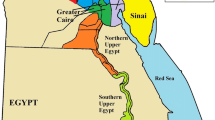Summary
Three SNaPshot multiplex assays were developed to test 23 coding region single nucleotide polymorphisms (SNPs) and one control region SNP outside hypervariable regions (HVR)I and II, which was aimed at increasing the discrimination power of the mitochondrial DNA (mtDNA) typing in forensic casework, and confirming haplogroup assignments of mtDNA profiles in both human population studies and medical research. The selected SNPs targeted the East Asian phylogeny. These multiplex assays were validated by comparing with the sequencing analysis of samples chosen randomly. The mtDNA variations of 100 unrelated individuals from the Wuhan population in China were examined and classified into 31 haplotypes, and the haplotype diversity was estimated to be 0.952. The multiplex SNaPshot method is rapid and robust, and suitable for large-scale screening studies of mtDNA variability.
Similar content being viewed by others
References
Ginther C, Issel-Tarver L, King MC. Identifying individuals by sequencing mitochondrial DNA from teeth. Nat Genet, 1992,2:135–138
Holland MM, Parsons TJ. Mitochondrial DNA sequence analysis—validation and use for forensic casework. Forensic Sci Rev, 1999,11:22–50
Wittig H, Augustin C, Baasner A, et al. Mitochondrial DNA in the central European population. Human identification with the help of the forensic mt-DNA D-loop-base database. Forensic Sci Int, 2000,113(1–3): 113–118
Holland MM, Cave CA, Holland CA, et al. Development of a quality, high throughput DNA analysis procedure for skeletal samples to assist with the identification of victims from the World Trade Center attacks. Croat Med J, 2003,44(3):264–272
Macaulay V, Hill C, Achilli A, et al. Single, rapid coastal settlement of Asia revealed by analysis of complete mitochondrial genomes. Science, 2005, 308(5724):1034–1036
Gilbert MT, Djurhuus D, Melchior L, et al. MtDNA from hair and nail clarifies the genetic relationship of the 15th century Qilakitsoq Inuit mummies. Am J Phys Anthropol, 2007,133(2):847–853
Allen M, Andréasson H. Mitochondrial D-loop and coding sequence analysis using pyrosequencing. Methods Mol Biol, 2005,297:179–196
Coble MD, Just RS, O’Callaghan JE, et al. Single nucleotide polymorphisms over the entire mtDNA genome that increase the power of forensic testing in Caucasians. Int J Legal Med, 2004,118(3):137–146
Vallone PM, Just RS, Coble MD, et al. A multiplex allele-specific primer extension assay for forensically informative SNPs distributed throughout the mitochondrial genome. Int J Legal Med, 2004,118(3): 147–157
Köhnemann S, Sibbing U, Pfeiffer H, et al. A rapid mtDNA assay of 22 SNPs in one multiplex reaction increases the power of forensic testing in European Caucasians. Int J Legal Med, 2008,122(6):517–523
Quintans B, Alvarez-Iglesias V, Salas A, et al. Typing of mitochondrial DNA coding region SNPs of forensic and anthropological interest using SNaPshot minise-quencing. Forensic Sci Int, 2004, 140: 251–257
Tzen CY, Wu TY, Liu HF. Sequence polymorphism in the coding region of mitochondrial genome encompassing position 8389–8865. Forensic Sci Int, 2001, 120(3):204–209
Sobrino B, Brión M, Carracedo A. SNPs in forensic genetics: a review on SNP typing methodologies. Forensic Sci Int, 2005,154(2–3):181–194
Underhill PA, Jin L, Lin AA, et al. Detection of numerous Y-chromosome biallelic polymorphisms by denaturing high-performance liquid chromatography. Genome Res, 1997,7(10):996–1005
Walsh PS, Metzger DA, Higuchi R. Chelex 100 as a medium for simple extraction of DNA for PCR-based typing from forensic material. Biotechniques, 1991, 10(4): 506–513
Nei M. Molecular evolutionary genetics. New York: Columbia University, 1987,176–181
Wu J, Ran P, Zhang B, et al. Multiplex mutagenically separated polymerase chain reaction assay for rapid detection of human mitochondrial DNA variations in coding area. Croat Med J, 2008,49(1):32–38
Umetsu K, Tanaka M, Yuasa I, et al. Multiplex amplified product-length polymorphism analysis of 36 mitochondrial single-nucleotide polymorphisms for haplogrouping of East Asian populations. Electrophoresis, 2005,26(1):91–98
Lee HY, Yoo JE, Park MJ, et al. East Asian mtDNA haplogroup determination in Koreans: haplogrouplevel coding region SNP analysis and subhaplogrouplevel control region sequence analysis. Electrophoresis, 2006,27(22):4408–4418
Alvarez-Iglesias V, Jaime JC, Carracedo A, et al. Coding region mitochondrial DNA SNPs: targeting East Asian and Native American haplogroups. Forensic Sci Int Genet, 2007,1(1):44–55
Liu YC, Hao JP, Yan JW, et al. Detecting the polymorphisms in mitochondrial DNA coding area using denaturing high-performance liquid chromatography (dHPLC). Chin J Forensic Med (Chinese), 2006, 21(3):142–146
Parsons TJ, Coble MD. Increasing the forensic discrimination of mitochondrial DNA testing through analysis of the entire mitochondrial DNA genome. Croat Med J, 2001,42(3):304–309
Kong QP, Bandelt HJ, Sun C, et al. Updating the East Asian mtDNA phylogeny: a prerequisite for the identification of pathogenic mutations. Hum Mol Genet, 2006,15(13):2076–2086
Chen BW, Zeng FM, Lu F, et al. Mitochondrial DNA polymorphism of mongolians populations in China and its forensic evaluation. Chin J Forensic Med (Chinese), 2007,22(2):81–84
Yao YG, Kong QP, Bandelt HJ, et al. Phylogeographic differentiation of mitochondrial DNA in Han Chinese. Am J Hum Genet, 2002,70(3):635–651
Tanaka M, Cabrera VM, González AM, et al. Mitochondrial genome variation in eastern Asia and the peopling of Japan. Genome Res, 2004,14(10A):1832–1850
Author information
Authors and Affiliations
Corresponding author
Additional information
These authors contributed equally to this work.
Rights and permissions
About this article
Cite this article
Huang, D., Gui, C., Yi, S. et al. Typing of 24 mtDNA SNPs in a Chinese population using SNaPshot minisequencing. J. Huazhong Univ. Sci. Technol. [Med. Sci.] 30, 291–298 (2010). https://doi.org/10.1007/s11596-010-0345-4
Received:
Published:
Issue Date:
DOI: https://doi.org/10.1007/s11596-010-0345-4




